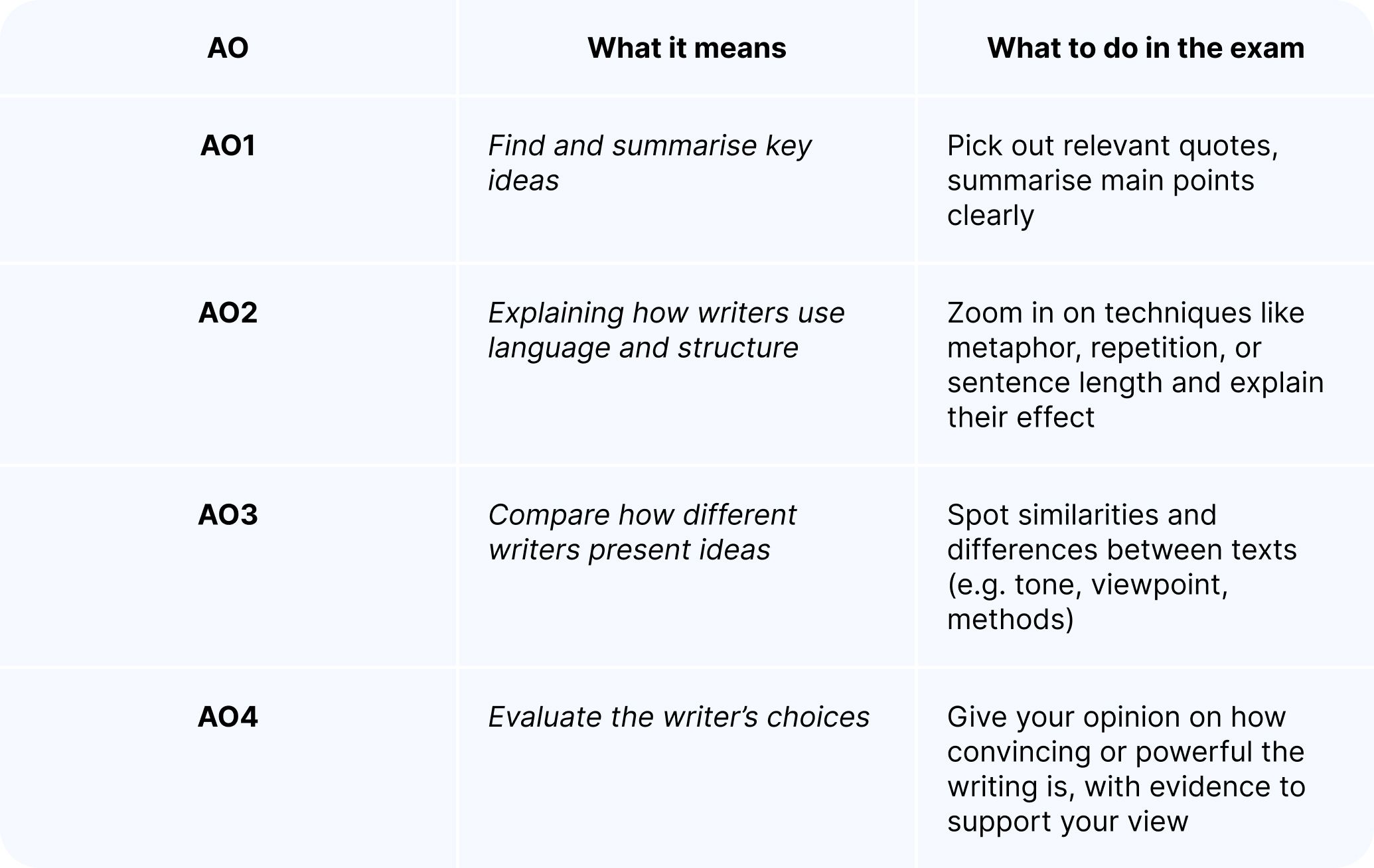GCSE English Language breakdown: topics, learning objectives & sample questions
By Atom | Sep 10, 2025, 3:06 PM
Contents
Struggling to keep up with the skills-heavy demands of GCSE English Language? You’re not alone. Unlike other GCSEs, there’s no set content to revise, making it trickier to know what to focus on. With the right strategy, however, it can be broken down into clear skills, topics, and techniques that are easy to practise.
What this post covers:
The structure of the GCSE English Language course
Assessment objectives explained
Key skills and topic areas
Example questions from each paper
Tips for effective revision
Why English Language matters for GCSE success:
GCSE English Language is a core subject that almost all sixth forms, colleges, apprenticeships and employers require.
It is more than a qualification; it reflects the ability to read with understanding, write clearly and communicate ideas effectively. These skills support progress in every other subject and are highly valued beyond education, from preparing applications to contributing in the workplace. Strong communication underpins success in both academic and everyday contexts.
What is GCSE English Language?
GCSE English Language assesses how well students can understand, interpret and respond to a range of fiction and non-fiction texts. It also tests their ability to write accurately and effectively for different audiences and purposes.
Unlike English Literature, there’s no requirement to study set texts. Instead, students are examined on unseen texts ranging from 19th-century novels to modern blog posts.
Exam board structure
Most GCSE students will take AQA, Edexcel or OCR. All boards follow a similar format with two main papers:

There’s also a separate Spoken Language endorsement, which is assessed alongside the main papers but does not contribute to the final GCSE grade. Instead, students receive a separate result of Pass, Merit, Distinction or Not Classified.
This component is included for all of the main exam boards and assesses students’ ability to prepare and deliver a formal presentation on a chosen topic and respond to questions and feedback. While it won’t affect the final grade, it helps develop essential communication, confidence, and clarity skills, qualities that are valued in further education and the workplace.
How to prepare for the Spoken Language endorsement
Though it doesn’t count towards the final GCSE grade, the Spoken Language endorsement is still a formal requirement and an excellent opportunity to build confidence in public speaking. Most students complete it in Year 10 or early Year 11.
What does it involve?
You’ll be assessed on three key skills:
Content: Planning and delivering a clear, well-structured talk on a topic of your choice
Delivery: Using appropriate tone, pace, body language and eye contact
Interaction: Responding effectively to audience questions
Students receive a grade of Pass, Merit or Distinction depending on how well they meet these criteria.
Example presentation topics
Should schools ban mobile phones?
The benefits of learning a musical instrument
Fast fashion and its environmental impact
Top tips for success
Students should choose a topic they’re passionate about – it’s easier to engage your audience when you care about your subject
Use cue cards instead of a full script to keep delivery natural
Practise with friends, teachers or family members to build confidence and refine timing
Record the presentation to review tone, pace and body language
Prepare for questions - anticipate what the audience might ask and plan responses
Many students find this part of the course enjoyable and empowering. It’s a valuable chance to practise real-world communication skills that extend far beyond the English classroom.
Understanding the key assessment objectives (AOs)
Every GCSE English Language exam is marked using assessment objectives, or AOs. Examiners use these official criteria to decide how many marks a student gets for each question.
Why do they matter?
If you know what each AO is testing, students can tailor their answers to hit the right targets and avoid losing marks for missing the point. Whether it’s analysing a text or writing their own, understanding the AOs will encourage students to stay focused and structure their work effectively.
Here’s a breakdown of what each AO means in simple terms:
Reading AOs (50% of total mark)
These apply to questions where you’re analysing unseen texts.

Writing AOs (50% of total mark)
These apply to the creative and persuasive writing sections.

Understanding and practising each AO is key to improving your exam performance. Think of them as a checklist; the more boxes you tick in your answer, the higher your marks will be.
Key topics and skills
Rather than memorising content, students need to master core skills across both reading and writing.
Reading skills
Identifying explicit and implicit meanings
Analysing language (e.g. metaphor, tone, sentence length)
Commenting on structure (e.g. narrative viewpoint, paragraph shifts)
Comparing viewpoints across texts
Evaluating the impact of the writer’s methods
Writing skills
Using ambitious vocabulary and varied sentence structures
Writing for different purposes: argue, advise, inform, describe, narrate
Adapting tone and style for the audience
Structuring writing clearly with introductions, paragraphs and conclusions
Sample questions and tasks
Here are examples of what students might face on each paper:
Paper 1: Fiction and imaginative writing
Reading (extract from a 20th-century novel):
How does the writer use language to create tension in this extract?
Writing task: Write a description of a stormy night, as suggested by this image.
Top tip: Plan your narrative arc. Even short descriptions should have a sense of structure.
Paper 2: Non-fiction and transactional writing
Reading (two extracts: 19th-century and modern non-fiction):
Compare how the two writers convey their attitudes to travel.
Writing task: “We rely too much on technology.” Write an article for a school magazine in which you argue your point of view.
Top tip: Use persuasive devices like triplets, rhetorical questions and anecdotes.
Revision tips and strategies
Here’s how to build exam confidence with regular practice:
For reading:
Read a mix of fiction and non-fiction regularly (e.g. novels, speeches, editorials)
Annotate extracts for language and structure
Practise comparing texts on similar themes
Time yourself answering AO2 and AO3 questions
For writing:
Build a vocabulary bank of powerful verbs, imagery and connectives
Plan and write practice responses to past paper questions
Use feedback to target specific AO5 and AO6 skills
Read your writing aloud to check tone, clarity and flow
Common challenges and how to tackle them
“I never know what to write in the analysis question.”
Use the PEEL structure: Point, Evidence, Explain, Link. Focus on just one or two devices per paragraph.
“I ran out of time on Paper 2.”
Stick to the timing: 15 minutes reading, 45 minutes writing (reading section), 5 minutes planning, and 40 minutes writing for the extended writing task.
“My writing feels boring.”
Try sentence variety, figurative language, and specific detail. Swap “It was cold” for “The frost bit at her fingertips.”
Final thoughts
With the right strategy and tools, GCSE English Language doesn’t need to be stressful. Focus on consistent revision, practise past questions, and remember small steps lead to big gains.
Don’t miss Atom’s GCSE giveaway!

Six months. Six epic prizes. Six chances to make the GCSE season unforgettable.
We’re launching Atom for GCSE prep in 2026, and to celebrate, over the next six months, we’re giving away thousands of pounds worth of prizes to help your child level up their GCSE revision.
Here’s a taste of what’s up for grabs:
The latest Apple tech, including an iPad Air, Vision Pro and more
Festival tickets for Boardmasters and Reading 2026
Europe interrail passes and £1,000 spending money
…and that’s just a few of the amazing prizes available.
Our first two winners have already taken home incredible prizes! Find out who they are and what they won in our latest giveaway update and keep an eye out for news of our November winner.
It’s free to join. UK only. Full T&Cs apply.
Contents
